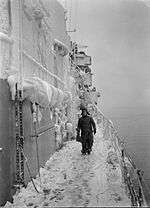HMS Scylla (98)
 Scylla at anchor on the Clyde, June 1942 | |
| History | |
|---|---|
| Name: | HMS Scylla |
| Builder: | Scotts Shipbuilding and Engineering Company (Greenock, Scotland) |
| Laid down: | 19 April 1939 |
| Launched: | 24 July 1940 |
| Commissioned: | 12 June 1942 |
| Out of service: | Constructive Total Loss (Write Off) 23 June 1944 |
| Identification: | Pennant number 98 |
| Fate: | Scrapped, Arrived at Thos W Ward, (Barrow-in-Furness, UK) 4 May 1950. |
| General characteristics | |
| Class and type: | Dido-class light cruiser |
| Displacement: |
|
| Length: |
|
| Beam: | 50.5 ft (15.4 m) |
| Draught: | 14 ft (4.3 m) |
| Propulsion: |
|
| Speed: | 32.25 knots (60 km/h) |
| Range: |
|
| Complement: | 480 |
| Armament: |
|
| Armor: |
|
HMS Scylla was a Dido-class cruiser of the Royal Navy. She was built by Scotts Shipbuilding and Engineering Company (Greenock, Scotland) , with the keel being laid down on 19 April 1939. She was launched on 24 July 1940, and commissioned 12 June 1942.
One of two sisters (the other was, appropriately, Charybdis, see Scylla and Charybdis), Scylla was completed with four twin QF 4.5 in Mk.III in UD MK III mountings because of a shortage of the intended QF 5.25 inch gun mountings.
The forward superstructure was considerably modified to accommodate these and also to increase crew spaces. Known as the 'toothless terrors', they proved to be very good anti-aircraft ships, often leading to comparisons with their sisters armed with the heavier QF 5.25-inch (133 mm) guns.
History

Scylla served with the Home Fleet on Arctic convoy duties. She carried a signals intelligence team headed by F/O RE Gunn and on at least one trip to the Kola Peninsula she is reported as having collected Signals Intelligence (PRO HW 14/53 and 55). She sailed for Gibraltar on 28 October 1942. The following month she was at the French North Africa landings (Operation Torch) as part of Force "O" with the Eastern Task Force, but in December was sent into the Bay of Biscay as part of the effort to catch homecoming Axis blockade runners.
On 31 December 1942 she was directed to the German blockade runner Rhakotis by a RAF Coastal Command Whitley from 502 Squadron based at RAF St Eval, Cornwall. The aircraft piloted By F/O Arthur Hodgson had located Rhakotis in appalling weather after several attack runs they had run out of ammunition. The crew then shadowed the target for over an hour, reporting the vessel's position enabling Scylla to intercept Rhakotis some 200 miles (320 km) north-west of Cape Finisterre in position 45°01′N 10°30′W / 45.01°N 10.50°W, when Scylla opened fire the Germans scuttled the ship. F/O Hodgson was awarded the DFC for his part in the operation. In February she returned to the Home Fleet for Arctic convoys, but was back in the Bay of Biscay by June 1943 to cover anti-submarine operations.
In July 1943 she stopped the Arklow schooner Mary B Mitchell in the Bay of Biscay. Captain Dowds, formerly principal of the Irish Nautical College, was captain of the schooner. The officer in charge of the boarding party was a pupil of Dowds. There was a pleasant reunion, then Mary B Mitchell resumed her voyage to Lisbon, and Scylla continued her search for blockade runners.[1]
In September 1943 Scylla was part of the Support Carrier Force at the Salerno landings (Operation Avalanche), but came home to refit for duty as an Escort Carrier Flagship in October, which lasted until April 1944. She was present at the Normandy landings as flagship of the Eastern Task Force.
On 23 June 1944 Scylla was badly damaged by a mine and declared a constructive total loss. Although towed to Portsmouth, she was not disposed of until 1950, after use as a target between 1948 and 1950. She arrived at Thos W Ward, (Barrow-in-Furness, UK) on 4 May 1950 for breaking up.
_model.jpg)
References
Publications
- Colledge, J. J.; Warlow, Ben (2006) [1969]. Ships of the Royal Navy: The Complete Record of all Fighting Ships of the Royal Navy (Rev. ed.). London: Chatham Publishing. ISBN 978-1-86176-281-8. OCLC 67375475.
External links
| Wikimedia Commons has media related to HMS Scylla (98). |
- WWII cruisers
- HMS Scylla at Uboat.net
- Newsreel video of HMS Scylla fighting the Luftwaffe while protecting convoy PQ18